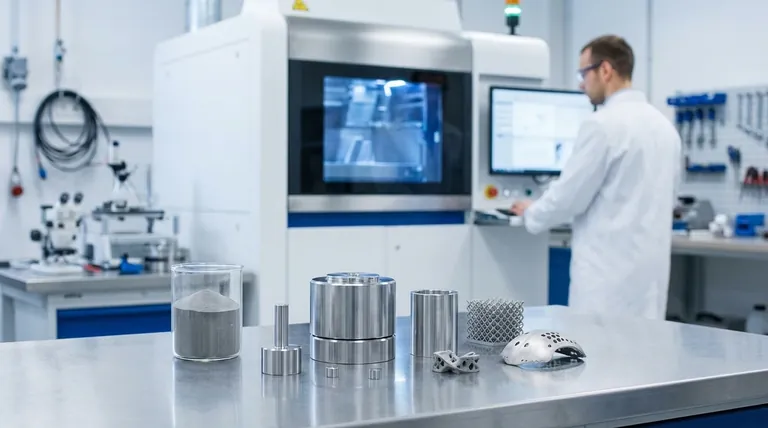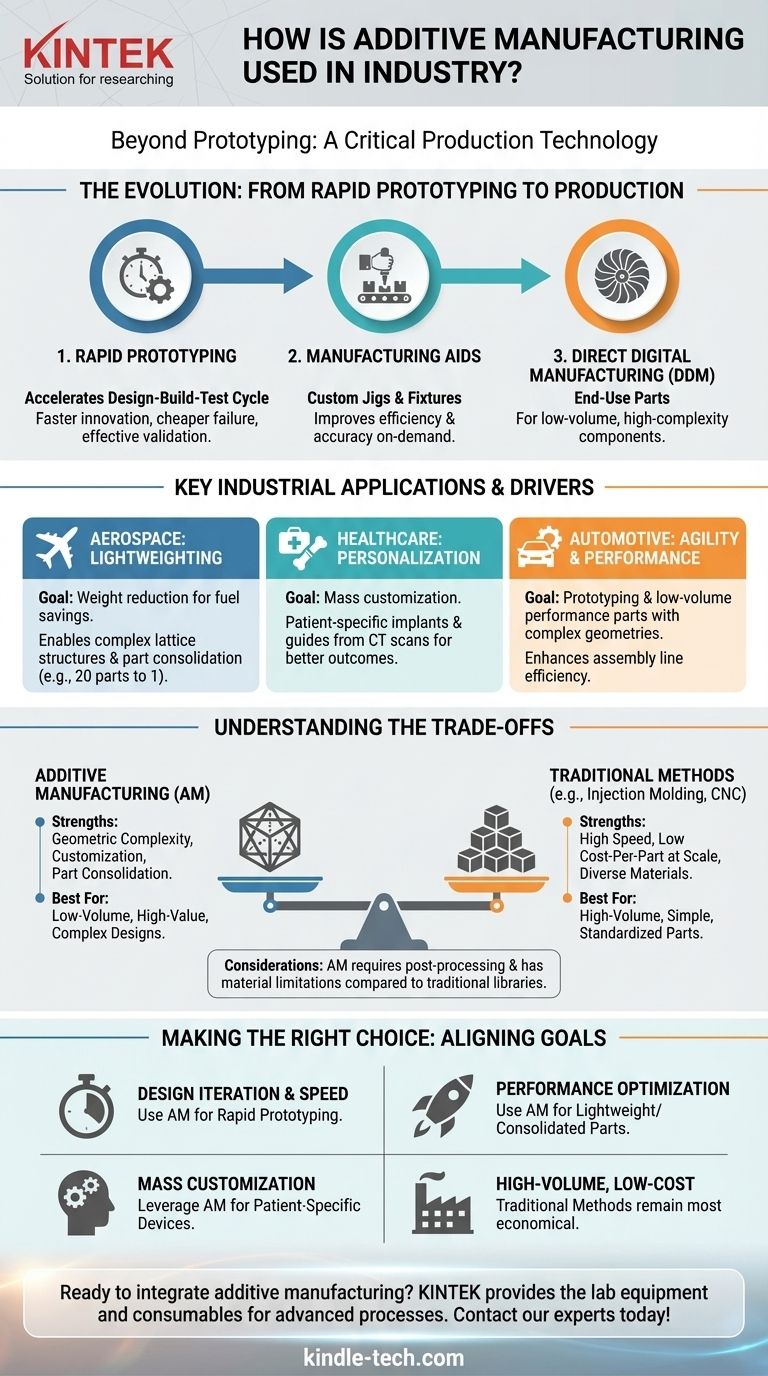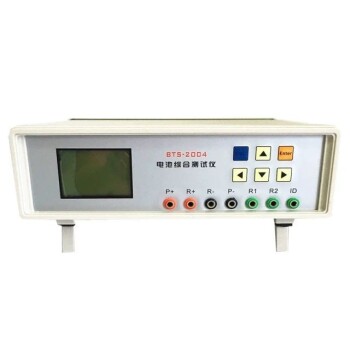在现代工业中,增材制造不再仅仅是新奇原型制作的工具。它已成为一种关键的生产技术,用于制造轻量化的航空航天部件、患者定制的医疗植入物以及高度复杂的工装夹具。通过直接从数字文件逐层构建物体,各行各业正在从根本上重新思考零件的设计、测试和规模化制造方式。
增材制造(AM)在工业环境中的核心价值不仅仅是3D打印一个物体。它在于能够解锁几何复杂性,从而实现制造出比传统制造方法更坚固、更轻、功能更强大的零件。
从快速原型制作到生产
增材制造,通常被称为3D打印,最初在一个关键领域开启了其工业之旅,但现已发展成为一种全面的生产方法。
基础:快速原型制作
最初,增材制造的主要用途是快速原型制作。它赋予工程师在几小时而不是几周内就能拿到其数字设计实体模型的能力。
这极大地加速了设计-构建-测试的循环。它允许在投入昂贵的批量生产工装之前,实现更快的创新、更廉价的失败以及更有效的产品验证。
演变:制造辅助工具
增材制造一个重要的、高价值的应用是制造夹具、固定装置和其他制造辅助工具。这些是装配线上用于在加工、检查或装配过程中固定零件的定制工具。
传统上,制造这些工具既耗时又昂贵。有了增材制造,工厂可以按需打印出定制化、轻量化且符合人体工程学的夹具,直接提高其现有制造过程的效率和准确性。
目标:直接数字制造(DDM)
最终目标,如今在许多行业已成为现实,是直接数字制造(DDM)。这涉及使用增材制造来生产最终进入产品的成品零件。
对于小批量生产、高度定制化的零件或设计复杂性带来显著性能优势的部件,DDM的价值最高。

关键工业应用及其驱动因素
不同的行业利用增材制造来解决截然不同的核心问题。该技术的灵活性是其最大的优势。
航空航天:追求轻量化
航空航天工业利用金属增材制造工艺,如烧结,来实现一个主要目标:减轻重量。在飞机上,每减轻一公斤都意味着在其整个生命周期内可节省大量燃料并增加有效载荷能力。
增材制造使工程师能够设计出具有复杂内部晶格结构的零件,这些结构在保持强度的同时去除了不必要的质量。它还实现了零件整合,即将由20个不同组件组成的组件重新设计并打印成一个更轻、更可靠的零件。
医疗保健:个性化需求
在医学领域,“一刀切”很少是最佳选择。增材制造以前所未有的规模实现了大规模定制,特别是在手术植入物和导板方面。
医生可以利用患者的CT扫描来设计和打印一个与患者独特解剖结构完美匹配的膝关节植入物、颅骨板或牙冠。这改善了患者的治疗效果,缩短了手术时间,并最大限度地减少了并发症。
汽车:敏捷性和性能
汽车行业在整个产品生命周期中都使用增材制造。它被广泛用于原型制作新的车辆设计和组件。
对于高性能和豪华车,增材制造用于生产小批量的最终用途零件,这些零件具有复杂的几何形状,可以改善气流或减轻重量。它对于创建定制的夹具和固定装置也至关重要,这些工具使汽车装配线更具敏捷性和效率。
了解权衡
增材制造是一个强大的工具,但它不能完全取代传统方法。了解其局限性是有效利用它的关键。
规模和速度的挑战
对于生产数千个简单、相同的零件,注塑成型或CNC加工等传统方法仍然是每件零件速度更快、成本更低。在批量生产的纯粹数量和速度方面,增材制造难以竞争。
材料特性和后处理
虽然增材制造材料的范围正在扩大,但它仍然比可用于传统制造的金属和塑料的庞大库藏更为有限。
此外,许多增材制造的零件,尤其是金属零件,需要后处理步骤,如热处理、表面抛光或机加工,才能达到最终所需的性能和公差。这些步骤会增加过程的时间和成本。
单位成本方程式
增材制造的商业案例很少取决于成为简单零件的最便宜选项。其价值必须来自于无法通过其他方式实现的性能提升。
这包括轻量化零件带来的燃油效率提高、定制植入物带来的患者治疗效果改善,或快速原型制作带来的产品开发加速等益处。
为您的目标做出正确的选择
有效应用增材制造需要将该技术的优势与您的特定工业目标相结合。
- 如果您的主要重点是设计迭代和上市速度:使用增材制造进行快速原型制作,以快速验证形状、装配和功能。
- 如果您的主要重点是性能优化:使用增材制造来创建传统方法无法实现的轻量化或整合型零件,尤其是在航空航天或高性能领域。
- 如果您的主要重点是大规模定制:利用增材制造来制造患者定制的医疗设备或个性化是关键价值驱动力的小批量定制产品。
- 如果您的主要重点是大批量、低成本生产:对于简单、标准化的零件,传统制造方法仍然是最经济的选择。
归根结底,增材制造是一种战略能力,当应用于正确的问题时,它重新定义了工程和生产中可能实现的事物。
总结表:
| 应用 | 行业 | 关键驱动因素 |
|---|---|---|
| 轻量化组件 | 航空航天 | 减重和燃油效率 |
| 患者定制植入物 | 医疗保健 | 大规模定制和改善治疗效果 |
| 快速原型制作和夹具 | 汽车 | 上市速度和装配效率 |
| 直接数字制造 (DDM) | 多个 | 小批量、高复杂度生产 |
准备将增材制造集成到您的工作流程中? KINTEK 专注于提供先进制造过程所需的实验室设备和耗材,从材料测试到质量控制。无论您身处航空航天、医疗还是汽车行业,我们的解决方案都能帮助您实现精度和效率。请立即联系我们的专家,讨论我们如何支持您的创新项目!
图解指南














